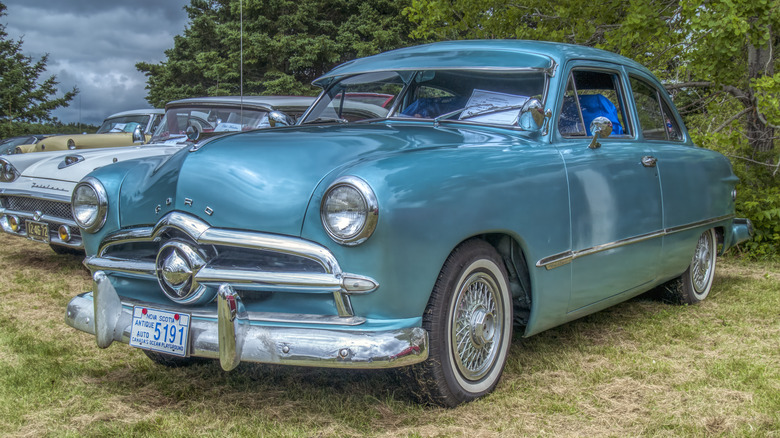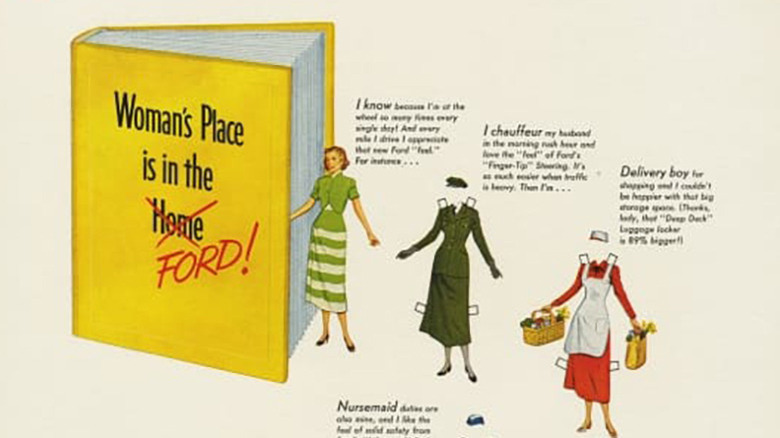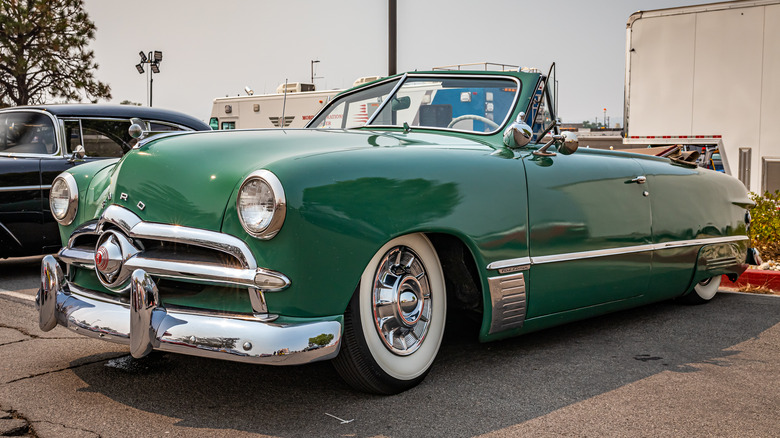What Made The 1949 Ford So Influential On The Future Of Car Design
The Ford Motor Company thrived in the first half of the 20th century largely due to the success of the legendary Model T, and by World War II, Ford had firmly established itself as one of the United States' "Big Three" automakers alongside General Motors and Chrysler. By that time, cars had evolved from flimsy carriage-like vehicles with thin, spoked wheels to generously appointed steel boxes with expansive glass windshields and sturdy roofs. When WWII ended in August in 1945, industrial production shifted back to civilian commercial interests, and veterans coming home had growing families and disposable income. In 1949, Ford introduced its first new postwar model as an answer to those new market realities. Ford debuted the '49 in June 1948 for a crowd of more than 55,000 people at the Waldorf-Astoria hotel in New York, and the striking new design would later win the Fashion Academy Award.
The car arrived on the market in two forms: the base 1949 Ford and the Ford Custom. Both were available as a two- or four-door sedan. The base Ford model also offered a 3-person coupe version, while the Custom could be had as a convertible or station wagon. This wasn't Ford's only success of the era — The 1953 F-100 is still held in high regard.
The 1949 Ford was marketed heavily to women
Ford would sell over a million vehicles in 1949. In part, that success came from an innovative business strategy for the time: marketing to women. Early ads capitalized on social trends like suburbanization and the Baby Boom that had more women driving more miles than ever before, pitching the car as equally suited for working women and domestic errands. Other carmakers followed suit; in 1955, Dodge introduced a version of the Custom Lancer called the La Femme that had a pink and white color scheme and came with an umbrella, raincoat, and makeup kit.
Pandering aside, the research and development process for the 1949 Ford was intensive and the result was striking: At the time, Newsweek called it the most radical redesign Ford had attempted since the Model A. Ford describes the 1949 as "the vehicle that saved Ford Motor Company," both for its sales numbers and because it set design trends that carried on well into the following decades. But the '49 Ford's origin story is nowhere near as smooth as its rounded front end.
Bob Gregorie's initial design was deemed too large and expensive by Ford execs, so that car became the 1949 Mercury. Ford then brought in an outside firm led by George Walker, who would later go on to design the classic 1950s Ford Thunderbirds. Walker's team raced with Gregorie's to come up with a new design, but neither was having much luck until Walker brought in former Studebaker designer Richard Caleal.
The 1949 Ford had airplane-inspired design features
Working from home and without a salary, Caleal and former Studebaker colleagues Bob Bourke and Holden "Bob" Koto whipped up a clay model of a completely new design in just three weeks. Ford's top brass chose Caleal's design over Gregorie's and the company finally got to work on the classic 1949. The design created by Caleal and his team stood out at once because it seamlessly integrated the fenders and front quarter panels, giving the car its signature rounded look. Everything suggested aerodynamics: A spinner logo that resembled an airplane propeller went in the center of the single-bar grille, and a scrapped early proposal would have put the speedometer in a WWII aircraft-style heads-up display.
After losing the design competition, Gregorie left Ford. Walker and Caleal went on to long careers in the company, with Walker hired as Vice President of design. Ford made $177 million in profit from the 1949 Ford, helping catapult the automaker into the industry's 1950s and '60s boom years.
The model's aerodynamic front end and rear wheel skirts carried over into many other cars that followed, and the aircraft-inspired styling and liberal use of chrome accents became popular design elements in the years to come. The 1949 Ford's undeniably striking design also made it popular with Hollywood producers; it was featured prominently in dozens of TV shows and films, like "The Wonder Years," "Zodiac," and "The French Connection."


